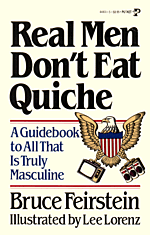Real Men Don't Eat Quiche

Real Men Don't Eat Quiche, by American Bruce Feirstein, is a bestselling tongue-in-cheek book satirizing stereotypes of masculinity, published in 1982 (ISBN 0-671-44831-5).
It popularized the term quiche-eater, referring to a man who is a dilettante, a trend-chaser, an over-anxious conformist to fashionable forms of lifestyle, and socially correct behaviors and opinions, one who eschews (or merely lacks) the traditional masculine virtue of tough self-assurance. A 'traditional' male might enjoy the ironically not so exotic egg-and-bacon pie if his wife served it to him; a quiche-eater, or Sensitive New Age Guy is alleged to make the dish himself, call it by its French name quiche, and serve it to his female life partner to demonstrate his empathy with the Women's Movement. Presumably, he would also wash up afterwards. These are also implied examples of 'women's work', and an attempt to taint the male character by association with such knowledge and activities.
The book's humor derives from the fears and confusion of contemporary 1980s middle-class men about how they ought to behave, after a decade of various forms of feminist critique on traditional male roles and beliefs.
The book was on the New York Times Best Seller list for 55 weeks, and sold over 1.6 million copies. An Australian adaptation by Alex Buzo was published later that year.
Sequels
The book was followed in 1982 by a cookbook, Real Men Don't Cook Quiche; a companion book by Joyce Jillson, Real Women Don't Pump Gas; and a 1983 book by illustrator Lee Lorenz titled Real Dogs Don't Eat Leftovers. For 1984, matching Real Men Don't Eat Quiche and Real Women Don't Pump Gas calendars were released. There were also many imitations from other publishers, most notably Real Kids Don't Say Please, Real Women Never Pump Iron and Real Women Send Flowers. In 1992, a sequel, Real Men Don't Bond, was released.
Cultural impact
- Real Programmers Don't Use Pascal: (usenet) is similar to Feirstein's book but concerns computer programming. It alleges that real programmers use the early Fortran programming language for everything that can't be toggled directly into the computer through binary switches on the front panel. The newer, innovative Unix was considered a little "quichey" by some in 1983, and Pascal especially so.
- In game theory, The Beer-Quiche game of Cho and Kreps[1] draws on the stereotype of quiche eaters being less masculine. This has become a standard example of a signaling game.
See also
- Chuck Norris facts, sayings about the masculinity of a fictionalized version of Chuck Norris, started on the Internet in 2005 and later adapted into several books.
- Metrosexual
- No true Scotsman
- Political correctness
- Sexism
References
- ↑ Cho, In-Koo; Kreps, David M. (May 1987). "Signaling Games and Stable Equilibria". The Quarterly Journal of Economics. 102: 179–222. doi:10.2307/1885060. JSTOR 1885060.